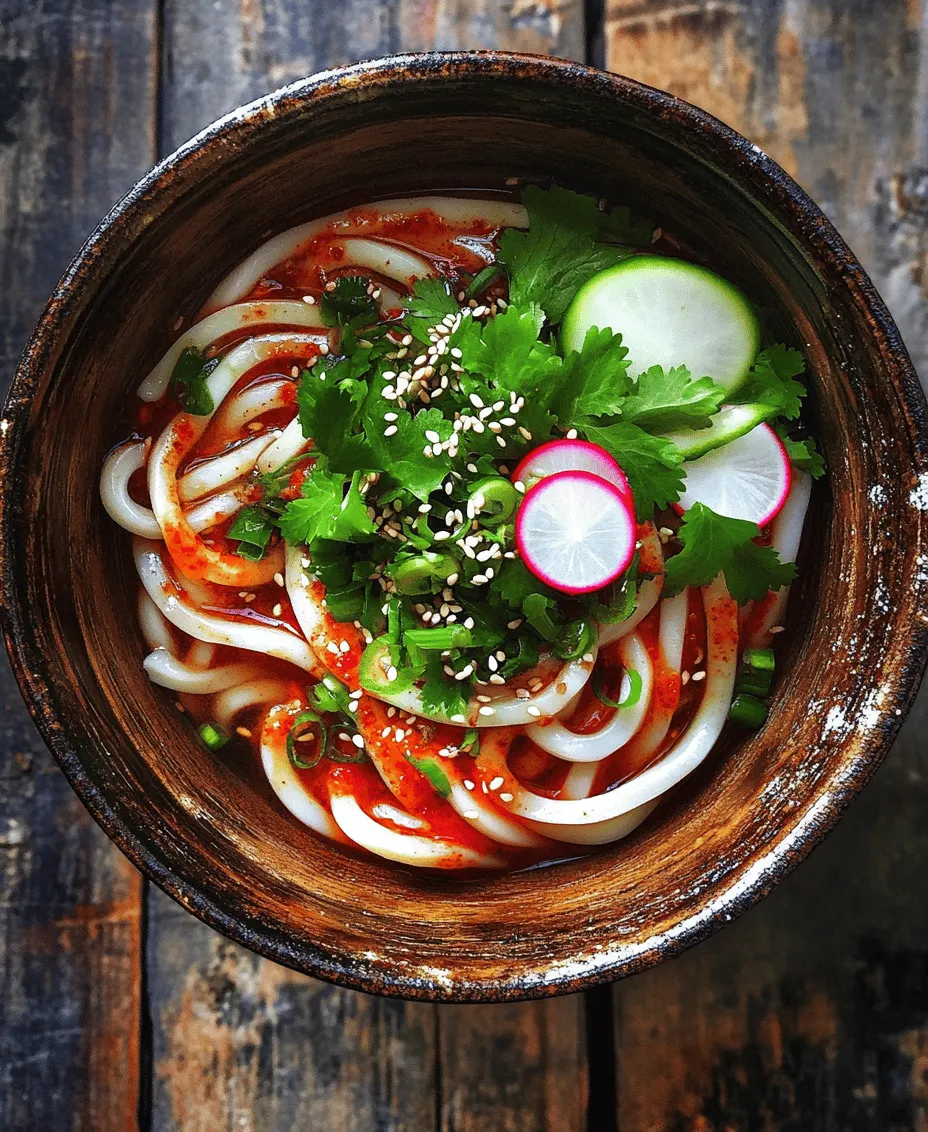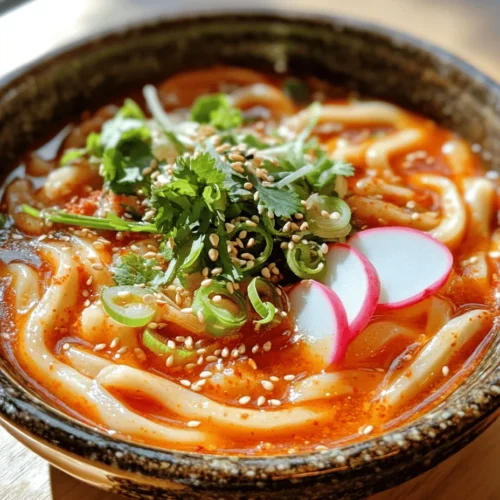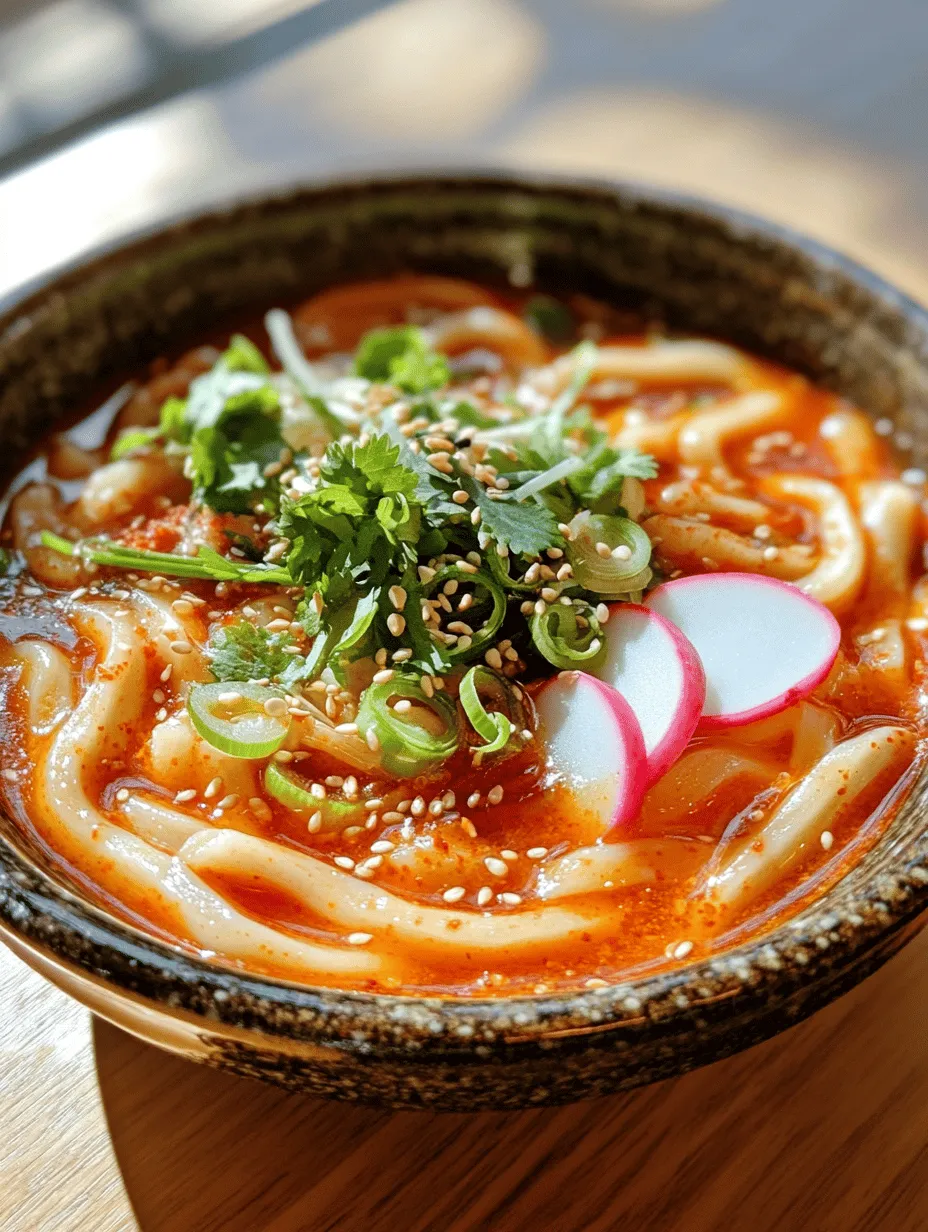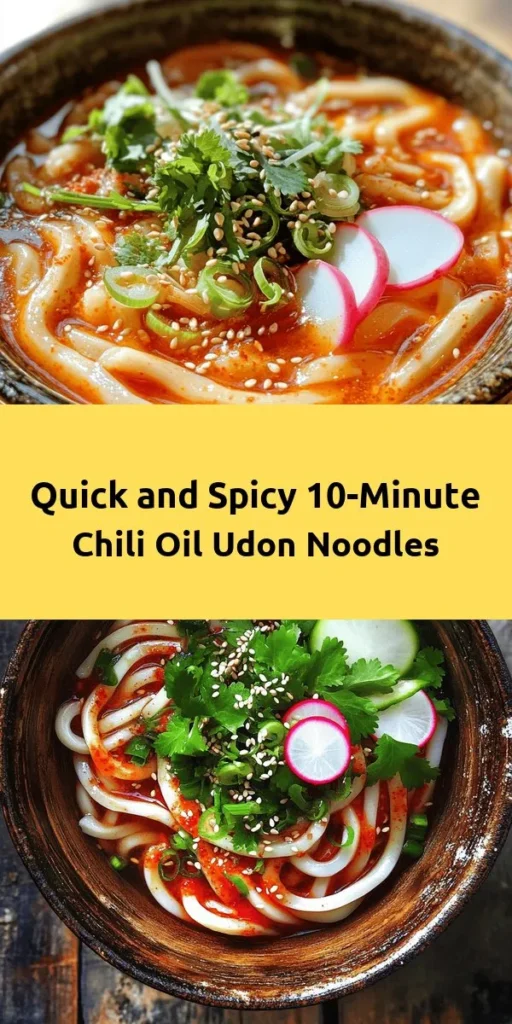Introduction
In the fast-paced world we live in, the demand for quick, delicious meals has never been higher. Enter Spicy 10-Minute Chili Oil Udon Noodles, a dish that beautifully combines convenience with robust flavors. This recipe is perfect for those evenings when you crave something satisfying yet easy to whip up — it’s an ideal solution for weeknight dinners, lunch breaks, or even a late-night snack.
Udon noodles are at the heart of this dish. Known for their thick, chewy texture and ability to absorb flavors, these Japanese noodles serve as a versatile base for myriad dishes, making them a staple in many kitchens. Their neutral taste allows them to shine brightly when paired with bold toppings and sauces, making them an excellent vehicle for the standout ingredient in this recipe: chili oil.
Chili oil is a culinary treasure, renowned for its ability to elevate a dish with just the right amount of heat and flavor. This spicy infusion combines oil with various spices, primarily chili peppers, to create a condiment that is as versatile as it is flavorful. In our Spicy 10-Minute Chili Oil Udon Noodles recipe, the chili oil plays a pivotal role, imparting a rich, spicy aroma that transforms simple noodles into a delectable meal.
As the trend towards quick and easy meals continues to grow, this recipe stands out not only for its speed — taking only 10 minutes to prepare — but also for its bold flavors. Whether you’re a busy professional, a student, or simply someone looking to enjoy a satisfying meal without spending hours in the kitchen, this dish is tailored for you.
Understanding Udon Noodles
Udon noodles are thick, wheat-based noodles that are a staple in Japanese cuisine. They are characterized by their chewy texture, which provides a delightful mouthfeel when cooked properly. Typically served in a hot broth or stir-fried with a variety of ingredients, udon noodles offer a pleasing experience that is both hearty and comforting.
Nutritional Benefits of Udon Noodles
Not only are udon noodles delicious, but they also pack a nutritional punch. They are a good source of carbohydrates, which provide the energy needed for an active lifestyle. Additionally, udon noodles are relatively low in calories compared to other pasta options, making them a great choice for those mindful of their caloric intake. Moreover, they are often fortified with additional nutrients like iron and B vitamins, further enhancing their health benefits.
Different Types of Udon Noodles Available in the Market
When shopping for udon noodles, you’ll find several varieties available in grocery stores. Fresh udon noodles are typically found in the refrigerated section, offering the best texture and flavor. Dried udon noodles are another popular option, boasting a longer shelf life and still delivering a satisfying chew when cooked correctly. There are also frozen udon noodles, which provide the convenience of quick preparation while retaining a freshness akin to the refrigerated varieties.
Suggestions on Where to Find Fresh Udon Noodles
To achieve the best results in your Spicy 10-Minute Chili Oil Udon Noodles, sourcing high-quality udon noodles is essential. Fresh udon can often be found in Asian grocery stores or specialty markets. If you don’t have access to these, many larger supermarkets now carry them in their international aisle. Alternatively, consider ordering online for convenience, ensuring you select a reputable supplier to guarantee the freshness of your noodles.
The Flavor Profile of Chili Oil
Chili oil is a beloved condiment in many cuisines, known for its ability to enhance dishes with a vibrant flavor and a kick of heat. The base of chili oil typically consists of vegetable oil infused with crushed red pepper flakes, garlic, and sometimes other spices like Sichuan peppercorns, which add a unique depth to the flavor.
Explanation of Chili Oil and Its Ingredients
The essence of chili oil lies in its simplicity. The primary ingredient, oil, acts as a carrier for the spices and allows the flavors to meld beautifully. The heat from the chili flakes combined with the aromatic properties of garlic creates a symphony of flavors that can elevate any dish. Some variations include additional ingredients such as sesame oil, which adds nuttiness, or ginger for a hint of warmth.
Overview of How Chili Oil Enhances Dishes
Incorporating chili oil into your dishes transforms the ordinary into the extraordinary. Whether drizzled over noodles, used as a marinade, or added to soups, chili oil introduces an irresistible flavor that draws people in. Its versatility allows it to complement various cuisines, including Asian, Italian, and even Tex-Mex, making it a must-have in any kitchen.
Cultural Significance of Chili Oil in Various Cuisines
Chili oil has deep cultural roots in many Asian cuisines, especially in Chinese and Thai cooking. In Chinese cuisine, it’s often used as a dipping sauce or a flavor enhancer for stir-fries. In Thailand, chili oil is a staple condiment that accompanies many dishes, reflecting the country’s love for bold flavors and spice. This rich history adds a layer of depth to the enjoyment of chili oil, making it not just an ingredient but also a part of culinary tradition.
Tips on Selecting High-Quality Chili Oil
When choosing chili oil, quality matters. Look for products that use natural ingredients without artificial additives or preservatives. A high-quality chili oil should have a rich color and a balanced flavor profile, not overly greasy or salty. If you’re feeling adventurous, consider making your own chili oil at home, allowing you to customize the heat level and flavors to suit your palate.
Ingredients Breakdown
To create the delectable Spicy 10-Minute Chili Oil Udon Noodles, it’s essential to understand the role of each ingredient. Here’s a breakdown of what you’ll need to make this flavorful dish:
– Udon Noodles: The star of this recipe, udon noodles provide the perfect chewy texture that pairs beautifully with the chili oil.
– Chili Oil: The key flavor enhancer, chili oil adds heat and richness to the dish.
– Soy Sauce: This umami-rich condiment adds depth to the flavor profile, balancing the spice of the chili oil.
– Garlic: Fresh garlic infuses the dish with aromatic qualities, enhancing its overall appeal.
– Green Onions: Sliced green onions offer a fresh crunch and mild onion flavor that complements the noodles.
– Sesame Seeds: Toasted sesame seeds add nuttiness and a pleasing crunch, enriching the texture of the dish.
Nutritional Information for Each Component
Understanding the nutritional value of each ingredient can help you make informed choices. Udon noodles typically contain around 200 calories per serving, providing a good source of carbohydrates. Chili oil can vary in calories depending on the brand, but it generally contains around 120 calories per tablespoon. Soy sauce is low in calories but high in sodium, so use it judiciously. Garlic is low in calories and packed with antioxidants, while green onions and sesame seeds add minimal calories while providing vitamins and minerals.
Possible Substitutions for Dietary Restrictions
For those with dietary restrictions, substitutions can easily be made. For a gluten-free option, consider using rice noodles or gluten-free udon noodles. To make the dish vegan, ensure your chili oil and soy sauce do not contain any animal products. You can also swap out traditional soy sauce for tamari or coconut aminos for a gluten-free alternative.
The Role of Each Ingredient in Achieving the Final Flavor
Each ingredient in this recipe contributes to the overall flavor and texture of the dish. The udon noodles provide a hearty base, while the chili oil offers the spice and richness needed to elevate the dish. Soy sauce adds umami depth, and garlic brings aromatic qualities that tie everything together. Green onions and sesame seeds not only enhance the flavor but also bring visual appeal to the finished dish.
Step-by-Step Cooking Instructions
Boiling the Udon Noodles
To achieve the perfect texture for your Spicy 10-Minute Chili Oil Udon Noodles, start by boiling the udon noodles. Bring a large pot of water to a rolling boil. Once boiling, add the udon noodles and cook according to the package instructions. Fresh udon typically cooks in about 2-3 minutes, while dried udon may take longer. Stir occasionally to prevent sticking.
Importance of Cooking Time for Texture
The cooking time for udon noodles is crucial to achieving the ideal texture. Overcooking can lead to mushy noodles, while undercooking results in a chewy, hard center. Aim for a perfect al dente texture where the noodles are firm but not hard, providing that signature chewiness that udon is known for. Once cooked, drain the noodles and rinse them under cold water to stop the cooking process and remove excess starch.
Now that we have laid the groundwork for creating your Spicy 10-Minute Chili Oil Udon Noodles, you’re well on your way to experiencing this delightful dish. Stay tuned for the continuation of this article, where we will delve into the rest of the cooking process, tips for perfecting your dish, and answers to some common questions.

Tips for Rinsing and Cooling the Noodles
Rinsing and cooling your udon noodles properly is crucial for preventing them from sticking together and ensuring they maintain a delightful texture. To start, once the noodles are cooked according to package instructions—usually around 8-10 minutes—drain them in a colander. Immediately rinse the noodles under cold running water for about 30 seconds. This step halts the cooking process, ensuring they don’t become mushy.
After rinsing, let the noodles cool completely in the colander for a few minutes. If you’re preparing ahead of time, you can toss them lightly in a small drizzle of sesame oil to prevent sticking. This also adds a subtle nutty flavor that enhances the overall dish.
Preparing the Sauce
The sauce is the heart of your Spicy 10-Minute Chili Oil Udon Noodles, providing the essential flavor that pulls the dish together. In a mixing bowl, combine soy sauce, chili oil, rice vinegar, and a pinch of sugar. The soy sauce offers a savory umami base, while the chili oil adds heat and depth. Rice vinegar introduces a tangy note that balances the spiciness.
To amplify the flavor profile, consider adding minced garlic and ginger. These ingredients not only enhance the overall taste but also bring a fragrant aroma that makes the dish irresistible.
Emphasis on Balancing Flavors
Achieving the perfect balance of flavors is vital in any dish, especially in a spicy noodle recipe like this one. You want to ensure that the spiciness from the chili oil doesn’t overpower the savory notes of the soy sauce or the tanginess of the rice vinegar. Taste your sauce as you mix it, adjusting the components to your preference. If it’s too spicy, add a touch more sugar or soy sauce to mellow it out. If you desire more heat, a few extra drops of chili oil can elevate the dish without overwhelming it.
Techniques for Maximizing Garlic Flavor
Garlic is a prominent flavor in this dish, and there are several techniques to maximize its impact. For a more robust garlic flavor, sauté minced garlic in a small amount of oil before adding it to your sauce. This method releases the essential oils and creates a more intense garlic base.
Alternatively, if you prefer a milder garlic taste, add the minced garlic directly to the sauce without cooking it first. This will give a fresher flavor profile. Combine the garlic with ginger for a harmonious blend that complements the spiciness of the chili oil.
Combining Ingredients
Once you have your noodles rinsed and cooled and your sauce prepared, it’s time to bring everything together. In a large mixing bowl, add the cooled udon noodles and pour the sauce over them. Using tongs or chopsticks, gently toss the noodles to coat them evenly with the sauce. This step is critical for ensuring that every strand of noodle is enveloped in the rich, spicy flavor.
Best Practices for Tossing Noodles with Sauce
When tossing your noodles with the sauce, be gentle yet thorough. The goal is to avoid breaking the delicate noodles while ensuring an even distribution of the sauce. Use a folding motion rather than a vigorous stirring action. This technique will help maintain the integrity of the udon while allowing the flavors to meld beautifully.
How to Achieve a Consistent Coating
For a consistent coating, it’s beneficial to let the noodles rest for a couple of minutes after tossing them with the sauce. This brief resting period allows the noodles to absorb the flavors more deeply. If you find that the sauce is clumping together, you can add a teaspoon of water or more chili oil to loosen it up and help it coat the noodles evenly.
Adding Toppings
To elevate your Spicy 10-Minute Chili Oil Udon Noodles, consider adding various toppings that contribute both texture and flavor. Some popular options include sliced green onions, toasted sesame seeds, or crushed peanuts for a delightful crunch.
For an extra layer of freshness, add chopped cilantro or Thai basil. If you prefer a protein boost, consider topping with poached eggs, grilled chicken, or tofu. Each of these toppings not only enhances the dish’s flavor but also adds nutritional value.
Presentation Tips for an Appealing Dish
Presentation plays a pivotal role in the enjoyment of your meal. Serve your Spicy 10-Minute Chili Oil Udon Noodles in a wide, shallow bowl to showcase the colorful toppings. Garnish with a sprinkle of sesame seeds and a few sprigs of fresh herbs for a pop of color. Drizzling a little extra chili oil on top can also create an inviting sheen that makes the dish even more appetizing.
Serving Suggestions and Variations
When it comes to serving your Spicy 10-Minute Chili Oil Udon Noodles, consider the temperature preferences of your guests. These noodles can be enjoyed warm or at room temperature, making them versatile for any occasion. If serving warm, you might want to offer a side of steamed vegetables to complement the dish’s heat.
For a more filling meal, consider adding proteins like grilled shrimp, chicken, or beef. Vegetarians can opt for marinated tofu or edamame for added protein.
If you wish to customize the dish further, think about incorporating different sauces or herbs. For instance, a drizzle of hoisin sauce can add a sweet, savory note, while fresh lime juice can provide a zesty brightness.
Nutritional Benefits of Spicy Udon Noodles
Beyond being delicious, Spicy Udon Noodles also offer several nutritional benefits. Udon noodles are primarily made from wheat, providing a good source of carbohydrates that fuel your body. The addition of garlic and ginger not only enhances the flavor but also contributes antioxidant properties, promoting overall health.
The balance of carbohydrates, healthy fats from the sesame oil, and proteins from suggested toppings makes this dish a well-rounded option. When enjoyed as part of a balanced diet, these noodles can be a satisfying meal choice that supports energy levels and nutrition.
Conclusion
In summary, Spicy 10-Minute Chili Oil Udon Noodles deliver on both simplicity and bold flavor. This dish is quick to prepare, making it an ideal option for busy weeknights or last-minute gatherings. With the ability to customize flavors and toppings, it invites creativity in the kitchen, encouraging you to experiment with different ingredients.
Embrace the deliciousness and uniqueness of this recipe, and don’t hesitate to make it your own. Quick meals like this one not only save time but also provide an opportunity to explore diverse culinary flavors. Whether you’re enjoying a solo dinner or serving friends, these spicy udon noodles are sure to impress and satisfy. Enjoy the cooking experience, and dive into a bowl of comforting, flavorful goodness!



